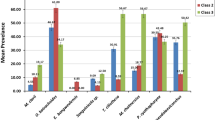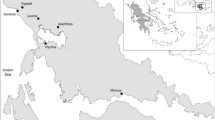Abstract
The parasite fauna of the stone loach (Barbatula barbatula) was investigated monthly from May to December 2001. Four parasite species were recorded: Gyrodactylus spp. (Monogenea), Tylodelphys clavata (Digenea), Proteocephalus sagittus (Cestoda), and Raphidascaris acus (Nematoda). The changes in the seasonal dynamics of parasite infection were investigated throughout the 8 months. The potential effect of the reproductive investment of the host, measured by gonad mass and gonado-somatic index (GSI), on the parasite infection was tested against the prediction that, during periods of high reproductive investment (beginning of the breeding period or forming gonads after breeding), the fish are more susceptible to parasite infection. Differences between parasite loads between genders were also hypothesized. Seasonal differences in infection were observed for all parasite species studied. The values of GSI showed a pattern of energy accumulation in the pre-reproductive period and at the beginning of breeding, a decrease during breeding, and an increase in the post-breeding period. A similar pattern was observed for parasite abundance, a strong or weak increase in spring and/or autumn and a decrease during summer (July and August). Positive correlations between the abundance of Gyrodactylus spp. and R. acus and both gonad mass and GSI were found in females after eliminating the effect of fish weight. Our results suggest that stone loach females are more susceptible to parasite infection in periods of higher reproductive investment. The main factor determining the infection of T. clavata was fish size. The abundance of P. sagittus was positively correlated with GSI in the total fish sample with no detectable effect of sex or fish weight. The increase in cestode infection in spring supports the hypothesis that the parasite life cycle could by synchronized with the beginning of host reproduction, probably induced by increasing fish hormone levels in the spring.

Similar content being viewed by others
References
Baruš V, Oliva O (1995) Petromyzontes and Osteichthyes. Academy of Science of Czech Republic, Prague
Buchmann K (1997) Population increase of Gyrodactylus derjavini on rainbow trout induced by testosterone treatment of the host. Dis Aquat Organ 30:145–150
Buchmann K, Moller SH, Uldal A, Bresciani J (1997) Different seasonal infection dynamics of two species of eye-flukes (Displostomum spathaceum and Tylodelphys clavata) in rainbow trout (Oncorhynchus mykiss). Bull Eur Assoc Fish Pathol 17:165–170
Bush AO, Lafferty KD, Lotz JM, Shostak AW (1997) Parasitology meets ecology on its own terms: Margolis et al. revisited. J Parasitol 83:575–583
Chen YF, He DK, Cai B, Chen ZM (2004) The reproductive strategies of an endemic Tibetan fish, Gymnocephalus selincuoensis. J Freshw Ecol 19:255–262
Deerenberg C, Apanius V, Daan S, Bos N (1997) Reproductive effort decreases antibody responsiveness. Proc R Soc London B 264:1021–1029
Ergens R, Lom J (1970) Causative agents of fish diseases (in Czech). Academia, Prague
Georgiev B, Bisekov V, Genov T (1986) The staining method for cestodes with iron acetocarmine. Helminthologia 23:279–281
Hanzelová V, Gerdeaux D (2003) Seasonal occurrence of the tapeworm Proteocephalus longicollis and its transmission from copepod intermediate host to fish. Parasitol Res 91:130–136
Heins DC, Singer SS, Baker JA (1999) Virulence of the cestode Schistocephalus solidus and reproduction in infected threespine stickleback, Gasterosteus aculeatus. Can J Zool 77:1967–1974
Jackson LF, Sullivan CV (1995) Reproduction of white perch—the annual gametogenic cycle. Trans Am Fish Soc 124:563–577
Kennedy CR (1981) Long-term studies on the population biology of two species of eyefluke, Diplostomum gasterostei and Tylodelphys clavata (Digenea: Diplstomatidae), concurrently infecting the eyes of perch, Perca fluviatilis. J Fish Biol 19:221–236
Kennedy CR, Burrough R (1977) The population biology of two species of eyefluke, Diplostomum gasterostei and Tylodelphys clavata, in perch. J Fish Biol 11:619–633
Kennedy CR, Hine PM (1969) Population biology of the cestode Proteocephalus torulosus (Batsch) in dace Leuciscus leuciscus (L.) of the River Avon. J Fish Biol 1:209–219
Koskivaara M (1992) Environmental factors affecting monogeneans parasitic on freshwater fishes. Parasitol Today 8:339–342
Koskivaara M, Valtonen ET, Prost M (1991) Seasonal occurrence of gyrodactylid monogeneans on the roach (Rutilus rutilus) and variations between four lakes of different water quality in Finland. Aqua Fenn 21:47–55
Malavasi S, Fiorin R, Franco A, Torricelli P (2004) Somatic energy storage and reproductive investment in the grass goby Zosterisessor ophiocephalus. J Mar Biol Assoc U K 84:455–459
McPhail JD, Peacock SD (1983) Some effects of the cestode (Schistocephalus solidus) on reproduction in the threespine stickleback (Gasterosteus aculeatus): evolutionary aspects of a host-parasite interaction. Can J Zool 61:901–908
Moravec F (2001) Checklist of the metazoan parasites of fish of the Czech Republic and the Slovak Republic. Academia, Prague
Nordling D, Andersson M, Zohari S, Gustafsson L (1998) Reproductive effort induces specific immune response and parasite resistance. Proc R Soc Lond B 265:1291–1298
Reimchen TE, Nosil P (2001) Ecological causes of sex-biased parasitism in threespine stickleback. Biol J Linn Soc 73:51–63
Sanz JJ, Arriero E, Moreno J, Merino S (2001) Interactions between hemoparasite status and female age in the primary reproductive output of pied flycatchers. Oecologia 126:339–344
Scholz T (1999) Life cycles of species of Proteocephalus, parasites of fishes in the Palearctic region: a review. J Helminthol 73:1–19
Sheldon BC, Verhulst S (1996) Ecological immunology: costly parasite defences and trade-offs in evolutionary ecology. Trends Ecol Evol 11:317–321
Skarstein F, Folstad I (1996) Sexual dichromatism and the immunocompetence handicap: an observational approach using Arctic charr. Oikos 76:359–367
Skarstein F, Folstad I, Liljedal S (2001) Whether to reproduce or not: immune suppression and costs of parasites during reproduction in the Arctic charr. Can J Zool 79:271–278
Stearns SC (1992) The evolution of life histories. Oxford University Press, Oxford
Suzuki Y, Otaka T, Sato S, Hou YY, Aida K (1997) Reproduction related immunoglobulin changes in rainbow trout. Fish Physiol Biochem 17:415–421
Valtonen ET, Haaparanta A, Hoffmann RW (1994) Occurrence and histological response of Raphidascaris acus (Nematoda, Ascaridoidea) in roach from four lakes differing in water quality. Int J Parasitol 24:197–206
Wedekind C (1992) Detailed information about parasites revealed by sexual ornamentation. Proc R Soc Lond B 247:169–174
White KAJ, Grenfell BT, Hendry RJ, Lejeune O, Murray JD (1996) Effect of seasonal host reproduction on host-macroparasite dynamics. Math Biosci 137:79–99
Zelmer DA, Arai HP (1998) The contributions of host age and size to the aggregated distribution of parasites in yellow perch, Perca flavescens, from Garner Lake, Alberta, Canada. J Parasitol 84:24–28
Acknowledgements
This study was supported by the Grant Agency of the Academy of Sciences of the Czech Republic (project no. A 6093104 to M.P., B.K. and V.B.), Grant Agency of the Czech Republic (no. 524/01/1314 to V.B.), Research Project of the Masaryk University (no. MSM 143-1000-10), and Improving Human Potential Programme (COBICE project no. 510). A.Š. was funded by the Grant Agency of the Czech Republic, project no. 524/03/P108. The stay of A.Š. in France was funded by NATO fellowship. We would like to thank Serge Morand and Jean-François Martin from the Centre of Biology and Management of Populations, Montferrier sur Lez, France for useful comments on the first draft. We are very grateful to Iveta Douglas and Carey O. Cunningham from the FRS Marine Laboratory, Aberdeen, Scotland, for correction of the English. The experiments comply with the current laws of our country.
Author information
Authors and Affiliations
Corresponding author
Rights and permissions
About this article
Cite this article
Šimková, A., Jarkovský, J., Koubková, B. et al. Associations between fish reproductive cycle and the dynamics of metazoan parasite infection. Parasitol Res 95, 65–72 (2005). https://doi.org/10.1007/s00436-004-1261-y
Received:
Accepted:
Published:
Issue Date:
DOI: https://doi.org/10.1007/s00436-004-1261-y




